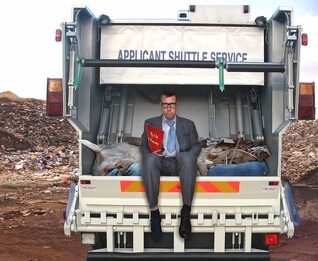 Halloween costumes are great. You get to pretend to be somebody that you're not. You can be a famous character. Maybe you like to dress up as somebody spooky, or like me, maybe you get roped into dressing up like one of the Adam's Family, so your wife is happy with your costume contest chances... Or the time my wife made me dress up as "Aunt Lydia" from the Handmaid's tale. It's all great. One of the challenges in human resources is that we constantly face is the fact that we have to put on a mask or a costume in order to do our job at times. A lot of times people perceive us as the company representative, or the principal's office, and in order to do their jobs, many HR professionals have to compartmentalize the work that they do. There's a lot of stress in our jobs. A lot of times, we have to make decisions that are very, very challenging. Sometimes, it doesn't feel like there are a lot of winners at the end of the day. In order to compartmentalize, a lot of us put on a mask or a costume when they walk into work. I can't tell you how many times I've had a conversation with an HR professional who comments that they feel like they can't be themselves at work, or that HR is simply the job that they do. But the HR work they do doesn't reflect the choices or the decisions that they make within their personal lives. So my question for an HR professional out there who feels like they have to put on a façade, or a costume or a mask, when they walk into work is this: WHY? If your employees don't feel like you are authentic, human, understanding, and empathetic, they won't come to you. You won't be a resource for them. You'll just be another person in a role that makes decisions about their livelihood, that has a huge impact on them. A lot of times I hear the argument that HR is supposed to be on the side of the people, or I hear HR is supposed to be a representative of the business. HR is supposed to be a part of the business strategy to improve culture, improve the people, and support the business and all of its success. That means that if an employee brings a complaint to HR, HR helps support that employee and the business to come to a win win solution. It's not about which side are you on, it's about the perspectives you support. HR's job should be to review these things in an empathetic and humanistic way. That means you can't be wearing a costume or a mask in the workplace. You can't compartmentalize human resources in your real life. It's all intertwined. Eventually, if you put on a mask or a costume at work, every single day that you go to work, you're going to burn out, you're going to crash and burn and it won't be fun. You'll either end up leaving the profession because you just can't handle it. Or you're going to be a really terrible HR practitioner. We ask our employees to be authentic, we ask our employees to bring concerns to us. Human Resources needs to have that outlet as well. Get connected with other professionals, either within your company or outside of your company. Learn about how to be appropriate and authentic, but also reflect your role. Ask yourself when you walk into work. Are you being true to yourself? Are you being authentic? Is your headspace in the right place so that you can hear somebody's concerns and have empathy for them? You need to understand the concerns of the business and some of the decisions that are really challenging for a business to make. Then you need to support and help an employee understand and then connect those two things together. Help an employee understand the logic of a business decision. Help a business understand an employee's concern in an empathetic way, and then work to address and build trust and respect within your organization and within your team. The best way to build trust is two words, competency and character. The only way to have competency is to practice and learn and get better. And the only way to have character is to be authentic and real. And in the spirit of Halloween. It never hurts to have a jar of candy in your office.
0 Comments
 Applicant Tracking Software is great. If you use it correctly. Used incorrectly, it sucks. In the world of HR. There's been a lot of talk about applicant tracking software in the world of job seekers. A lot of times what you'll hear about applicant tracking software is the concern about making sure that your resume has the appropriate number of keywords so that the applicant tracking software will find your resume and get it in the hands of a hiring manager. While this all sounds fine and dandy, I missed the class in HR School, where they told me that the best candidates had the best keywords on their resume. Another word in my mind for "keyword" is "BS". If somebody can fill out a resume full of fancy and flowery corporate buzzwords, then they have a better chance of getting caught by applicant tracking software, and getting that in the hands of a recruiter. It's totally weird. If you are an HR practitioner, and you are using an AI software to screen through resumes, I would encourage you to understand the limitations of that type of software. Right now it may make sense because we have so many resumes coming in with the huge unemployment numbers. We're not used to seeing that many resumes as we're posting jobs. It makes sense to have some sort of a screening filter method. If you are looking purely at the type of keywords that are used, on a resume, you're going to miss qualified talent. You need to have a human touch as you are recruiting, and you need to make sure that you are taking a look at a resume holistically. If you are an applicant and you are filling out a resume and you want to make sure you "beat the screening software", instead of trying to make sure that your resume matches all of the keywords in the position profile that you want it to, you need to target that company in a way that's appropriate for that role. A lot of times most of the most effective job searches are done through networking and connecting with others. If you have a connection, if you have an interest, if you have a passion, there are so many ways that you can go get connected with an organization right now and get your resume in the right person's hand. Do a quick Google search, and you can find out who is in human resources at that company. You can find contacts for hiring managers in the departments that you're applying for all of that information is out there, there's so much data that you can do that. Take the time to do that. If you really care about the job, you will take the time. HR people, if you're reading this, and you're thinking, "Oh, I hate it when people reach out to me or send me blind LinkedIn requests", or "Geez, I just I can't stand all of these emails from applicants." My question is why? That tells you that somebody is engaged, that shows you that somebody is interested, that tells you that somebody took the time, energy, put in some sweat equity to figure out who you are, and what you do, and make the effort to get that resume into your hands. For me, that's a clear sign that that person is a hard worker, that person cares. That person is the kind of person that I want on my team. There's a balance here. If somebody sends you a resume every single week and says have you looked at this yet, that might be a little bit much. But ultimately going out and doing the research and doing the work is exactly what I want in an employee. Let's give everybody a little bit of grace. If all you're looking at is keywords, you're looking at the wrong thing. Keywords are BS. Let's talk about employee privacy. Many people have had to flex their working from home situations to adapt to safety measures, and absolutely flip the world upside down.
With this world going crazy, and people working from home in much larger numbers, this has prompted some employers to try to understand ways that they can monitor and check in on employees. I think some of this is probably altruistic, they want to make sure that people are doing okay. They want to make sure that people stay connected to the office. And they want to make sure that that collaboration is occurring. But there is a dark side to this and it relates to employee privacy within their own homes as they're working from home. Earlier this year, the consultancy firm, PwC, came under fire for developing a facial recognition tool that logs when employees are away from their computer screens while working from home (creepy!) As it relates to the workplace, there's a number of privacy regulations that have come into play. Things like GDPR, which is the EU privacy regulations, and many states in the United States have come out and said that privacy is the right of an employee and an employer has a duty to protect employee information. So this is slip a slippery slope and employers, I would encourage you to think about a few things. If you're thinking about enacting employee tracking measures, the first thing is start to measure results first, before you assume that there's a problem. A lot of times myself included as I'm dealing with kids and schedules and adjusted schools, and a spouse that also works from home, my day doesn't end, at five o'clock. It usually lasts well into the evening. A lot of times, I'm the most productive between eight and 10pm after the children are asleep. A lot of employees are going through this right now. So keep that in mind. If you are tracking people on the hours they used to work from the office, and expecting them to do their work as part of a normal schedule, the question I would ask is, is it required to be done that way? If you don't require somebody to get their work done between a specific period of time, then what is the harm and allowing them to flex their time? I think this comes down to goal setting. How are you and your managers setting goals so that your employees can ensure that they understand exactly what you expect of them? Do they understand the timeline that you expect them to get it done in? If you manage this process effectively, your productivity should hopefully not diminish or at least you should be able to measure your productivity effectively. As opposed to having to resort to tracking software and facial recognition and creepy cell phone tracking programs and all those sorts of things. The other thing to think about is how do we collaborate in a virtual world that's positive and fun and helpful, as opposed to forcing people to just sit on zoom meetings for six to eight hours of their day to ensure that they're connected to the organization. There are many different ways that you can do this. There's many apps within Microsoft Teams and Slack. There are other ways that you can engage people to stay connected to your organization. If you're asking me: Do I want to work for the employer that I know has facial recognition tracking software that's going to track every time I sit down at my computer? I'm just gonna say No thanks. Creepy.  In this series, I want to highlight steps I took in my past organization to support an inclusive culture. English as a Second Language My organization, MasterBrand Cabinets, Inc., had a significant barrier to finding qualified employees. This organization was a manufacturing organization. We were seeing a significant amount of employee turnover, absenteeism, and other quality issues on our second shift. The job performed on the 2nd shift was not a very desirable job. It was dirty, hard physical work, and it was a challenge to retain new employees. Quite frankly, the work sucked, and we were seeing almost 100% employee turnover every year. We could not find enough applicants to fill the open spots, let alone qualified applicants willing to perform the work. Instead of whining about "no good applicants", we instead changed our thinking to "how can we find good applicants". We approached this by expanding the talent pool we recruited from. We reached out into their community and partnered with a local nonprofit, EMBARC, that was working directly with individuals who had a barrier to successful employment. In this case, the barrier was the English language. Many of the individuals that the nonprofit was serving did not speak English as a first language. Instead of focusing on what these individuals could not do, this organization focused on the skills that they had, and instead invested in training for the English language. We hired a certified trainer and translator, Poe (pictured), to help lead a crew of individuals who are learning how to speak English, effectively. This individual trained and translated in the area in need. He also referred over 20 employees to come work in this area. We partnered with Hawkeye Community College, our local school, and started teaching classes on site for those who wanted to learn English. We saw an overwhelmingly positive response to this program. The results of this program resulted in a zero percent turnover rate in the group over a six month period of time, compared to the previous turnover rate of 100%. The overtime in the department reduced by 75%. This is equated to roughly $12,000 in savings. The unplanned absenteeism rate within this area was 50% lower than the average absenteeism rate at the rest of the organization. In this case, inclusion became the strategy to address workforce needs, and became a wonderful Human Experience for all involved. Inclusion = Workforce solutions. WeAt one of my employers, we were seeing a significant drop off of new hires. We would find a great fit, and then they would just stop showing up after a week or two. We figured out the primary reason for many of these cases wasn't that they didn't like the job, but that they lost their transportation.
We took an innovative approach to supporting employee’s transportation needs. We did not have a bus route close to our location. As a result, many of our associates relied on rides from families and friends. New hires were not able to afford to purchase a vehicle or gas until after their first paycheck. I found out that one kind-hearted community member was getting up at 4AM to carpool 5 employees to our location! I've been in that boat before... Trying to figure out whether to put $5 of gas in the car or food in my stomach. It's not a good place to be, and it hurt me to think our employees were making that decision. The biggest challenge was for new hires. They didn't get a paycheck until two weeks on the job, so there was a gap in cashflow until they received their first payday. We decided to take action. We partnered with a local taxi agency called "The Loop". We worked with the taxi company and came up with a program that supported the new hires who needed financial support until they could afford to pay for gas or transportation. These new hires received a pass that allowed them to use the local taxi company services for their first few weeks of employment until they received a paycheck. We spent some money up front. Yes, this was a business expense, but it cost less than a background check and drug screen, and we were losing so many new hires, this expense was a no regrets decision. Some of the other actions that were taken were advocating with the local city to ensure that a bus route was put near our location. We also adjusted start times so that it was easier for employees to carpool to work together and to catch the bus in time. The results of this program were that new hires felt more supported, as they were starting with an organization. This prompted a very high word of mouth referral rate for new hires and ensured that the new hires that they invested time and resources into hiring for the organization, stuck around beyond the first few weeks of employment. The new hire turnover rate dropped, and the morale improved. At the end of the day, we cared out our employees, and that focus on their experience paid dividends.
My favorite classes in college were statistics and Operations management. Yes, I'm a nerd.
Nerd out with me as I interview a real-life rocket scientist about people analytics! :)  Human Resources' number one job is ensuring Leaders model the culture their organization needs to be successful. The behaviors below are a foundation of building an inclusive culture for leaders. These three traits will set a leader up for success in building an inclusive culture. 1. Model Behavior and Empathy One of the most important things that a leader can do is model the behavior that they expect from others. And one of the most important behaviors that you can model for an inclusive culture is empathy. Empathy is the ability to understand and share the feelings of another. A lot of times employees don't necessarily expect you to support how they feel, but they do expect you to attempt to understand where they are coming from. Empathy can be challenging, especially during a heated situation. So make sure that as you are thinking through how to respond to certain inflammatory scenarios that you take a moment to step back and think about another person's viewpoint. It will ensure you don’t make a poor decision, and may actually help diffuse any issue. 2. Address inappropriate behaviors So what do you do if somebody does something that's inappropriate? The first and most important thing to do is address it. It's best to have a conversation one on one. Having a private conversation is best, and a closed door and office is preferrable. The worst thing you can do is to not address it. By not addressing inappropriate behaviors, you have essentially endorsed those behaviors as appropriate. Don't participate in inappropriate behaviors. This goes without saying, but if somebody is acting in a non-inclusive way or doing something that could be inappropriate or hurtful to another,by participating, you also communicate that it's okay. Explain to the person what the consequences of inappropriate behaviors are, whether that's progressive discipline, a performance improvement plan or some other type of discipline, there need to be consequences for inappropriate behavior. If you have the ability to get HR involved do so if necessary. Sometimes it's best to partner with somebody who's an expert in addressing inappropriate behaviors. If someone comes to you and says that something happening is inappropriate, accept someone's perceptions as reality. Don't tell them that they're too sensitive or shouldn't feel the way they do. By doing this you automatically tell them that their opinions are not important and their perceptions are not real. You should acknowledge a person’s feelings. Ensure that they are addressed in a way that is appropriate and productive. 3. Demonstrate trust and understanding Nobody's perfect and we all make mistakes. If somebody brings something to you and feels like you were acting appropriately, thank them for feeling comfortable enough to address the issue with you. Try not to be defensive. Instead, try accountability. By being accountable and open to the feedback, you're communicating that you're willing to listen and change. Don't criticize them in return, or try to refute everything they said, acknowledge the validity of their perceptions and understand that everybody is going to have a different interpretation of the things that you do. A lot of times by focusing on the intent of something that you did can help defuse the situation. Improve. Always be open for improvement. Nobody has all of the answers and we are all learning every day. By being focused on continuous improvement and learning from others mistakes and from your past mistakes and engaging in empathetic and proactive behaviors, you will continue to get better as an inclusive and open leader.  The Platinum Rule “Treat others the way they want to be treated” We've all heard of the Golden Rule, which goes something like this: Do unto others as you would have them do to you. In other words, treat other people--in business and in life- the way you want to be treated. Well, Dave Kerpen, author of the book The Art of People, says that following the Golden Rule is all wrong. Instead, we should follow what he calls the Platinum Rule. Says Kerpen, "We all grow up learning about the simplicity and power of the Golden Rule: Do unto others as you would want done to you. It's a splendid concept except for one thing: Everyone is different, and the truth is that in many cases what you'd want done to you is different from what your partner, employee, customer, investor, wife, or child would want done to him or her." So Kerpen came up with the Platinum Rule: Do unto others as they would want done to them. Says Kerpen, "The Golden Rule, as great as it is, has limitations, since all people and all situations are different. When you follow the Platinum Rule, however, you can be sure you're actually doing what the other person wants done and assure yourself of a better outcome." The Platinum Rule is a foundational element of building a respectful, inclusive culture. It’s the first step in acknowledging differences and supporting those differences in a positive manner. How to build an inclusive culture So how do we create an inclusive culture? Simply being inclusive, is the best way to start. Take the time to get to know your team. When you understand more details about your team, you'll understand what things make them tick. What are their concerns, goals, and career objectives? Tailoring your leadership style and organizational structure to the goals of your employees will help your organization become effective. Treat each person as the individual that he or she is. Trying to make people conform will naturally make your culture less inclusive. Allow them to bring their authentic selves to work. Conformity at work is important for some processes, but flexibility for employees to be their natural selves will help them feel more comfortable and included. Share your own background and experiences. When you take time to share your story and connect with people on a more personal level, you give them a perspective, and naturally become a more inclusive leader. Get different perspectives before making decisions. When we've been in the workplace or doing our jobs for a number of years, it becomes very easy to revert to doing things the way that we've always done it. The most common thing heard in the workplace in my opinion is. “That's the way we've always done it.” That doesn’t mean it’s the right thing to do. Getting a different perspective before making a decision will ensure that you're not only inclusive, but helps validate that you're making good decisions and ultimately, that will drive to business success. Find the unique skills of each individual and celebrate them and support them in soaring with their strengths. By focusing on what people are good at, you will naturally incentivize them to do more of that skill. As you build your team, thinking about those different skills and complimentary skills can help you become a better team builder and actively seek to understand different points of view. Not everybody will agree with what you do. You will not always agree with others. Understanding the viewpoints that they have will help you become a more inclusive leader. Finally, adapt your communication or working style to meet the needs of your audience. Certain individuals will prefer direct, clear, and succinct communication. While some individuals may appreciate more communication, and more constant feedback and validation. It doesn't mean that one method is right or wrong, but being adaptable will ensure that you are creating an inclusive and effective culture. A few examples of behaviors you can try: 1. Establish a buddy system that connects each new associate with a veteran associate to help show them the ropes. By giving somebody a mentor, you are supporting them in their journey within your organization. As you have new employees join your organization, if they learn that you are supportive of their journey from the beginning, they will be more supportive of your organization. It's also great for the mentor to have a mentee, and a great way to recognize a top performer. 2. Find ways of challenging the status quo. Disruption will always be present in a workplace. If you find ways to positively disrupt processes and policies in positive ways, it's not only healthy for your organization, but it's also a great way to build an inclusive culture. 3. Foster an atmosphere of flexibility and learning. As you learn and develop yourself, ensure that others understand that you are resilient and adaptable, that you listen, and that you are flexible and that you expect others to be the same way. It all starts with leadership. Be Platinum. Gold is so "Old School". |
About The BlogAre you tired of the same old boring advice about how to succeed in your career? Do you feel like you're stuck in a rut and can't seem to break free? If so, then you need to check out our blog! Our blog is all about thinking differently when it comes to the world of work. We don't just regurgitate tired old advice - we bring you fresh insights from our own careers and from interviews with experts on our podcast, Rebel HR. So if you're ready to shake things up and start approaching your career in a new way, then our blog is a must-read. Don't settle for mediocrity - join us and let's revolutionize the world of work together! Archives
October 2023
Categories
All
|
 RSS Feed
RSS Feed
